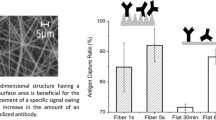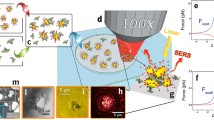Abstract
This paper reports a fabrication method that can make microstructures such as microfluidic channels and nanostructures to generate surface plasmon resonance (SPR) signals in one-step using hot embossing. We first made a micro/nanostructural mold on a silicon substrate through sequential e-beam lithography, reactive ion etching (RIE), photolithography, and inductively coupled plasma RIE. The fabricated mold and cyclo-olefin polymer (COP) film were pressed between two flat, heated metal bases under optimal conditions, and the micro/nanostructures were complementarily transferred to the COP film. After depositing a thin aluminum film onto the nanostructure, the device was completed by patterning Nafion that crossed two channels and a nearby nanostructure, and by bonding the COP film to a flat polydimethylsiloxane (PDMS) substrate with holes punched for the inlets and outlets. SPR signals of the nanostructures of the microfluidic channel were calibrated using glycerol solutions of different percentages, and a wavelength sensitivity of 393 nm/refractive index unit was found for the Al-based nanoslit SPR sensing chip. To detect macromolecules, we first modified bovine serum albumin (BSA) onto the surface of the SPR chip and then allowed different concentrations of anti-BSA samples to flow into the device. A calibration curve for detecting anti-BSA was constructed, and anti-BSA detection levels with and without preconcentration were compared.










Similar content being viewed by others
Data availability
The data that support the findings of this study are available from the corresponding author upon reasonable request.
References
Chang Y-C, Dvoynenko MM, Ke H et al (2021) Double resonance SERS substrates: Ag nanoparticles on grating. J Phys Chem C 125:27267–27274. https://doi.org/10.1021/acs.jpcc.1c07454
Chuang C-S, Wu C-Y, Juan P-H et al (2020) LMP1 gene detection using a capped gold nanowire array surface plasmon resonance sensor in a microfluidic chip. Analyst 145:52–60. https://doi.org/10.1039/C9AN01419E
Chung P-S, Fan Y-J, Sheen H-J, Tian W-C (2015) Real-time dual-loop electric current measurement for label-free nanofluidic preconcentration chip. Lab Chip. https://doi.org/10.1039/c4lc01143k
Das S, Devireddy R, Gartia MR (2023) Surface plasmon resonance (SPR) sensor for cancer biomarker detection. Biosensors (basel) 13:396. https://doi.org/10.3390/bios13030396
Deng C-Z, Fan Y-J, Chung P-S, Sheen H-J (2018) A novel thermal bubble valve integrated nanofluidic preconcentrator for highly sensitive biomarker detection. ACS Sens 3:1409–1415. https://doi.org/10.1021/acssensors.8b00323
Dutta P, Su T-Y, Fu A-Y et al (2022) Combining portable solar-powered centrifuge to nanoplasmonic sensing chip with smartphone reader for rheumatoid arthritis detection. Chem Eng J 434:133864. https://doi.org/10.1016/j.cej.2021.133864
Ebbesen TW, Lezec HJ, Ghaemi HF et al (1998) Extraordinary optical transmission through sub-wavelength hole arrays. Nature 391:667–669. https://doi.org/10.1038/35570
Fan Y-J, Deng C-Z, Chung P-S et al (2018) A high sensitivity bead-based immunoassay with nanofluidic preconcentration for biomarker detection. Sens Actuators B Chem 272:502–509. https://doi.org/10.1016/j.snb.2018.05.141
Fan Y-J, Huang M-Z, Hsiao Y-C et al (2020) Enhancing the sensitivity of portable biosensors based on self-powered ion concentration polarization and electrical kinetic trapping. Nano Energy 69:104407. https://doi.org/10.1016/j.nanoen.2019.104407
Geng Z, Kan Q, Yuan J, Chen H (2014) A route to low-cost nanoplasmonic biosensor integrated with optofluidic-portable platform. Sens Actuators B Chem 195:682–691. https://doi.org/10.1016/j.snb.2014.01.110
Homola J, Piliarik M (2006) Surface plasmon resonance (SPR) sensors. Springer Ser Chem Sens Biosens 4:45–67. https://doi.org/10.1007/5346_014
Homola J, Yee SS, Gauglitz G (1999) Surface plasmon resonance sensors: review. Sens Actuators B Chem 54:3–15. https://doi.org/10.1016/S0925-4005(98)00321-9
Hsiao H-H, Ke H, Dvoynenko MM, Wang J-K (2020) Multipolar resonances of ag nanoparticle arrays in anodic aluminum oxide nanochannels for enhanced hot spot intensity and signal-to-background ratio in surface-enhanced Raman scattering. ACS Appl Nano Mater 3:4477–4485. https://doi.org/10.1021/acsanm.0c00569
Hsieh H-Y, Chang R, Huang Y-Y et al (2022a) Continuous polymerase chain reaction microfluidics integrated with a gold-capped nanoslit sensing chip for Epstein-Barr virus detection. Biosens Bioelectron 195:113672. https://doi.org/10.1016/j.bios.2021.113672
Hsieh H-Y, Luo J-X, Shen Y-H et al (2022b) A nanofluidic preconcentrator integrated with an aluminum-based nanoplasmonic sensor for Epstein-Barr virus detection. Sens Actuators B Chem 355:131327. https://doi.org/10.1016/j.snb.2021.131327
Jian C, Zhang J, Ma X (2020) Cu–Ag alloy for engineering properties and applications based on the LSPR of metal nanoparticles. RSC Adv 10:13277–13285. https://doi.org/10.1039/D0RA01474E
Ko SH, Song YA, Kim SJ et al (2012) Nanofluidic preconcentration device in a straight microchannel using ion concentration polarization. Lab Chip. https://doi.org/10.1039/c2lc21238b
Kuo T-R, Chen Y-C, Wang C-I et al (2017) Highly oriented Langmuir-Blodgett film of silver cuboctahedra as an effective matrix-free sample plate for surface-assisted laser desorption/ionization mass spectrometry. Nanoscale 9:11119–11125. https://doi.org/10.1039/C7NR04098A
Kwak R, Kim SJ, Han J (2011) Continuous-flow biomolecule and cell concentrator by ion concentration polarization. Anal Chem. https://doi.org/10.1021/ac2012619
Lee K-L, Chen P-W, Wu S-H et al (2012) Enhancing surface plasmon detection using template-stripped gold nanoslit arrays on plastic films. ACS Nano 6:2931–2939. https://doi.org/10.1021/nn3001142
Lee K-L, Huang J-B, Chang J-W et al (2015) Ultrasensitive biosensors using enhanced fano resonances in capped gold nanoslit arrays. Sci Rep 5:8547. https://doi.org/10.1038/srep08547
Lee K-L, You M-L, Tsai C-H et al (2016) Nanoplasmonic biochips for rapid label-free detection of imidacloprid pesticides with a smartphone. Biosens Bioelectron. https://doi.org/10.1016/j.bios.2015.08.010
Lee K-L, You M-L, Wei P-K (2019) Aluminum nanostructures for surface-plasmon-resonance-based sensing applications. ACS Appl Nano Mater 2:1930–1939. https://doi.org/10.1021/acsanm.8b02325
Lezec HJ, Degiron A, Devaux E et al (2002) Beaming light from a subwavelength aperture. Science 297:820–822. https://doi.org/10.1126/science.1071895
Lu Y-J, Hsieh H-Y, Kuo W-C et al (2021) Nanoplasmonic structure of a polycarbonate substrate integrated with parallel microchannels for label-free multiplex detection. Polymers (basel) 13:3294. https://doi.org/10.3390/polym13193294
Mahmoudpour M, Ezzati Nazhad Dolatabadi J, Torbati M et al (2019) Nanomaterials and new biorecognition molecules based surface plasmon resonance biosensors for mycotoxin detection. Biosens Bioelectron 143:111603. https://doi.org/10.1016/j.bios.2019.111603
Masson J-F (2017) Surface plasmon resonance clinical biosensors for medical diagnostics. ACS Sens. https://doi.org/10.1021/acssensors.6b00763
Mostufa S, Akib TBA, Rana MdM, Islam MdR (2022) Highly sensitive TiO2/Au/graphene layer-based surface plasmon resonance biosensor for cancer detection. Biosensors (basel) 12:603. https://doi.org/10.3390/bios12080603
Mousavi M, Chen H-Y, Hou H-S et al (2015) Label-free detection of rare cell in human blood using gold nano slit surface plasmon resonance. Biosensors (basel) 5:98–117. https://doi.org/10.3390/bios5010098
Sheen H-J, Panigrahi B, Kuo T-R et al (2022) Electrochemical biosensor with electrokinetics-assisted molecular trapping for enhancing C-reactive protein detection. Biosens Bioelectron 210:114338. https://doi.org/10.1016/j.bios.2022.114338
Sherry LJ, Chang S-H, Schatz GC et al (2005) Localized surface plasmon resonance spectroscopy of single silver nanocubes. Nano Lett 5:2034–2038. https://doi.org/10.1021/nl0515753
Singh P (2016) SPR biosensors: historical perspectives and current challenges. Sens Actuators B Chem 229:110–130
Soler M, Belushkin A, Cavallini A et al (2017) Multiplexed nanoplasmonic biosensor for one-step simultaneous detection of Chlamydia trachomatis and Neisseria gonorrhoeae in urine. Biosens Bioelectron 94:560–567. https://doi.org/10.1016/j.bios.2017.03.047
Stewart ME, Anderton CR, Thompson LB et al (2008) Nanostructured plasmonic sensors. Chem Rev 108:494–521. https://doi.org/10.1021/cr068126n
Sui M, Kunwar S, Pandey P, Lee J (2019) Strongly confined localized surface plasmon resonance (LSPR) bands of Pt, AgPt, AgAuPt Nanoparticles. Sci Rep 9:16582. https://doi.org/10.1038/s41598-019-53292-1
Tan S-H, Yougbaré S, Tao H-Y et al (2021) Plasmonic gold nanoisland film for bacterial theranostics. Nanomaterials 11:3139. https://doi.org/10.3390/nano11113139
Wang YC, Stevens AL, Han J (2005) Million-fold preconcentration of proteins and peptides by nanofluidic filter. Anal Chem. https://doi.org/10.1021/ac050321z
Wang S-H, Lo S-C, Tung Y-J et al (2020) Multichannel nanoplasmonic platform for imidacloprid and fipronil residues rapid screen detection. Biosens Bioelectron 170:112677. https://doi.org/10.1016/j.bios.2020.112677
Xu T, Geng Z (2021) Strategies to improve performances of LSPR biosensing: Structure, materials, and interface modification. Biosens Bioelectron 174:112850. https://doi.org/10.1016/j.bios.2020.112850
Yougbaré S, Mutalik C, Krisnawati DI et al (2020) Nanomaterials for the photothermal killing of bacteria. Nanomaterials 10:1123. https://doi.org/10.3390/nano10061123
Yougbaré S, Chou H-L, Yang C-H et al (2021) Facet-dependent gold nanocrystals for effective photothermal killing of bacteria. J Hazard Mater 407:124617. https://doi.org/10.1016/j.jhazmat.2020.124617
Yu X, Liu X, Wang B et al (2020) An LSPR-based “push–pull” synergetic effect for the enhanced photocatalytic performance of a gold nanorod@cuprous oxide-gold nanoparticle ternary composite. Nanoscale 12:1912–1920. https://doi.org/10.1039/C9NR08808C
Zhao J, Zhang X, Yonzon CR et al (2006) Localized surface plasmon resonance biosensors. Nanomedicine 1:219–228
Zhou J, Qi Q, Wang C et al (2019) Surface plasmon resonance (SPR) biosensors for food allergen detection in food matrices. Biosens Bioelectron 142:111449
Acknowledgements
This work was supported by the National Science and Technology Council of Taiwan (grant nos. NSTC 112-2636-E-038-003, 111-2221-E-002-128, and 111-2811-E-002-030), and by Taipei Medical University Hospital (grant no. 112TMU-TMUH-07). We would also like to thank the NEMS Research Center, National Taiwan University for facility support.
Funding
Taipei Medical University Hospital, 112TMU-TMUH-07, National Science and Techology Council of Taiwan, NSTC 111-2811-E-002 -030, NSTC 111-2221-E-002 -128, NSTC 112-2636-E-038 -003.
Author information
Authors and Affiliations
Contributions
Y-JL, H-JS, Y-JF fund the project. Y-JL, and H-YH analyze the data, and draft the manuscript. W-FY collected the data. K-CW, HT provided the idea and proof the analyzed data. P-KW provided the idea and technique of fabrication. H-JS and Y-J Fan provide the fabrication skill, and finalized the manuscript. All authors reviewed the manuscript.
Corresponding authors
Ethics declarations
Conflict of interest
The authors declare no competing interests.
Additional information
Publisher's Note
Springer Nature remains neutral with regard to jurisdictional claims in published maps and institutional affiliations.
Rights and permissions
Springer Nature or its licensor (e.g. a society or other partner) holds exclusive rights to this article under a publishing agreement with the author(s) or other rightsholder(s); author self-archiving of the accepted manuscript version of this article is solely governed by the terms of such publishing agreement and applicable law.
About this article
Cite this article
Lu, YJ., Hsieh, HY., Yang, WF. et al. Co-printing of micro/nanostructures integrated with preconcentration to enhance protein detection. Microfluid Nanofluid 28, 3 (2024). https://doi.org/10.1007/s10404-023-02699-4
Received:
Accepted:
Published:
DOI: https://doi.org/10.1007/s10404-023-02699-4




